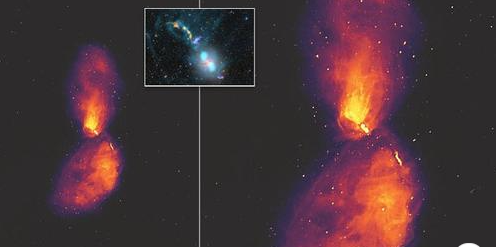A black hole eruption spanning 16 times the full Moon, around 12 million light years away from us, has been revealed in a new image by astronomers.
The image, captured by the Murchison Widefield Array (MWA) telescope in Australia, shows radio emission from a supermassive black hole in the centre of Centaurus A.
At a distance of 12 million light years, Centaurus A is a relatively close neighbour of our galaxy, the Milky Way.
The supermassive black hole at Centaurus A’s centre pours out vast amounts of radio energy and X-rays, according to scientists.
As the black hole feeds on in-falling gas, it ejects material at near light-speed, causing ‘radio bubbles’ to grow over hundreds of millions of years.
When viewed from Earth, the eruption from Centaurus A now extends eight degrees across the sky – the length of 16 full moons laid side by side.
Supermassive black holes residing in the centre of galaxies like Centaurus A are feeding off gas and dust that is attracted by their enormous gravitational pull.
This process releases massive amounts of energy and the galaxy is said to become ‘active’. Most matter lying close to the edge of the black hole falls in.
However, some of the surrounding particles escape moments before capture and are blown far out into space at speeds approaching the speed of light.
The new image reveals spectacular new details of the radio emission from the galaxy, according to Dr Benjamin McKinley at the International Centre for Radio Astronomy Research (ICRAR) in Perth, Western Australia.
‘These radio waves come from material being sucked into the supermassive black hole in the middle of the galaxy,’ he said.
‘It forms a disc around the black hole, and as the matter gets ripped apart going close to the black hole, powerful jets form on either side of the disc, ejecting most of the material back out into space, to distances of probably more than a million light years.
‘Previous radio observations could not handle the extreme brightness of the jets and details of the larger area surrounding the galaxy were distorted, but our new image overcomes these limitations.’
Centaurus A is the closest radio galaxy to our own Milky Way.
‘We can learn a lot from Centaurus A in particular, just because it is so close and we can see it in such detail,’ Dr McKinley said.
‘Not just at radio wavelengths, but at all other wavelengths of light as well.
‘In this research we’ve been able to combine the radio observations with optical and x-ray data, to help us better understand the physics of these supermassive black holes.’
Centaurus A appears brighter in the centre where it is more active and there is a lot of energy.
‘Then it’s fainter as you go out because the energy’s been lost and things have settled down,” said Dr McKinley.
‘But there are interesting features where charged particles have re-accelerated and are interacting with strong magnetic fields.’
MWA director Professor Steven Tingay said the research was possible because of the telescope’s extremely wide field-of-view, superb radio-quiet location and excellent sensitivity.
With the SKA, scientists will be able to survey billions of star systems and seek technosignatures ‘in an astronomical ocean of other worlds’, according to Professor Tingay.
‘The MWA is a precursor for the Square Kilometre Array (SKA) – a global initiative to build the world’s largest radio telescopes in Western Australia and South Africa,’ he said.
‘The wide field of view and, as a consequence, the extraordinary amount of data we can collect, means that the discovery potential of every MWA observation is very high. This provides a fantastic step toward the even bigger SKA.’



